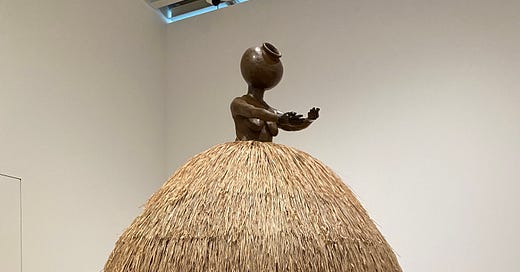My first encounter with the work of artist Simone Leigh was at the Whitney Museum in December of 2020, on one of the last days of that excruciating year. I remember wandering the museum alone on a Saturday afternoon, masked, socially distant, and vaguely terrified to be out in a public space, yet determined to enjoy a few hours away from my kids. The exhibition I’d come to see was called “Making Knowing: Craft in Art,” a theme that I hoped would provide some much needed inspiration. Leigh’s towering piece, Cupboard VIII, struck me from across the room.
Reaching to about ten feet high, the sculpture is composed of two parts - a large, dome-shaped structure covered in raffia topped by a stoneware female torso with outstretched arms and a vessel for a head. I spent several minutes taking in the surreal proportions and poignant gesture of this dreamlike figure. Despite its impressive scale and dominant presence in the gallery, the piece felt intimate and vulnerable. The faceless femme, her skin glazed a rich bronze, was like a distant ancestor asking to be seen, to be heard, to be remembered.
The mix of materials was especially compelling, particularly the use of raffia, which covered more than half of the piece. Considered a sustainable fiber, raffia comes from the segments of the leaves from the raffia palm, which originates in Africa and Madagascar. The leaves are harvested, stripped, and dried in the sun, shifting the color from green to the soft golden tan we associate with woven baskets. Used in a wide range of home decor and fashion accessories, raffia was not a material typically found in the context of a museum.
In “Cupboard VIII,” raffia is layered in four successive tiers that reach all the way to the ground. The rounded form reads as both a massive hoop skirt, and also a thatched roof or building, referencing Leigh’s interest in North and West African vernacular architecture. In further research, I found that raffia is used throughout her work, and appears as a covering for the exterior structure of Leigh’s presentation at the U.S. Pavilion at the 59th Venice Biennale, where she made history as the first Black woman to represent the country at the world’s top art festival.
As a parent to young children, the thatched raffia form found an unlikely point of reference in my brain - the story of the three little pigs, and the ill-fated house of straw blown down by the menacing wolf. The folktale is attributed to the English author, James Hallilwell-Phllips, who published The Nursery Rhymes of England, in 1886, though the story likely predates the written version. As I circled the sculpture, it occurred to me that the folktale could be a vestige of colonial propaganda, a narrative created to devalue native building materials and the dwellings of indigenous communities. As many times as I’d heard the story as a child and retold it as an adult, a piece of modern art was what made me rethink its meaning.
Curious about the title of the work, “Cupboard VIII,” I found an interview in Art Forum where Leigh provided context, “...I came back to my studio and returned to a body of work that I had started in Atlanta, using an odd restaurant called Mammy’s Cupboard as a point of departure. This metaphorical black woman’s cupboard is a large skirt where you can enter to eat pancakes. Formally, the spectacle of architecture meant to signify the inhabitation of a black woman’s body is stunning. But using the apparatus of its white ball-gown-shaped skirt to cover this embodiment aligns it with many social and political histories.” Leigh has used this grotesque silhouette to create a majestic and moving sculpture.
The memory of this piece has remained with me over the years. The tactile quality of the work drew me in, and its meaning grows deeper as I learn more.
Simone Leigh has an upcoming exhibition at the ICA in Boston from April 6 - September 4.
Here are some links to articles about Leigh’s work:
The Monumental Success of Simone Leigh (The New Yorker)
How Simone Leigh’s Sculptures Centering Black Women Brought Her to the Venice Biennale (Art News)
An Artist Ascendant: Simone Leigh Moves Into the Mainstream (The New York Times)
News
In keeping with the art theme, I’m sharing an article I wrote recently for Insider about why I take my kids to see art.
Thank you for reading!



